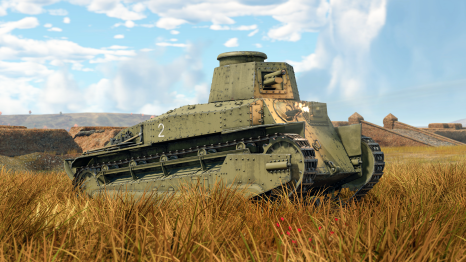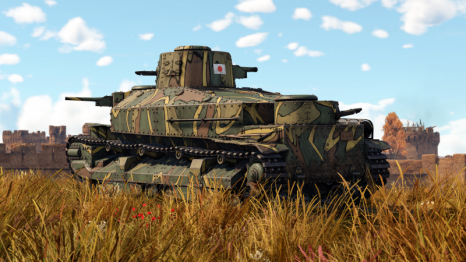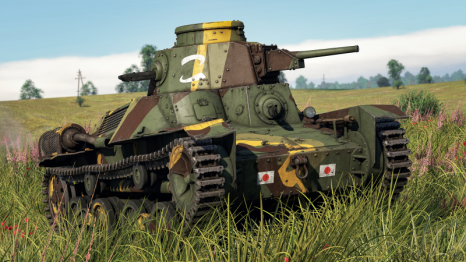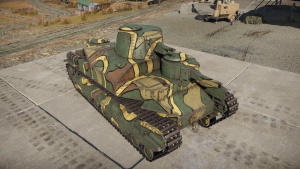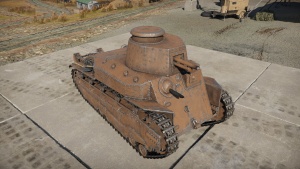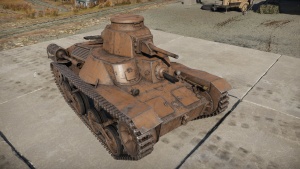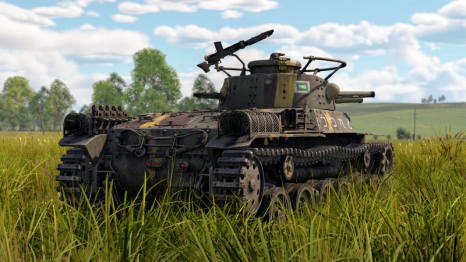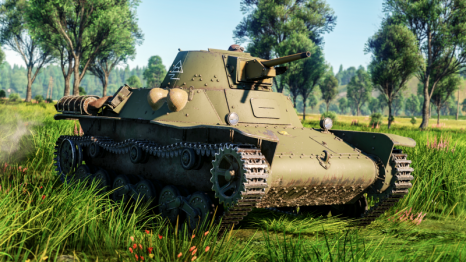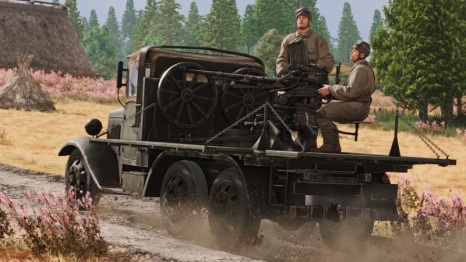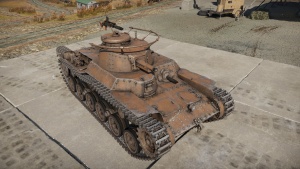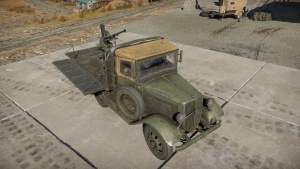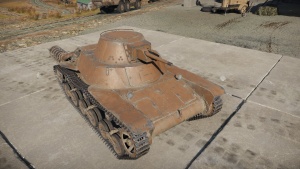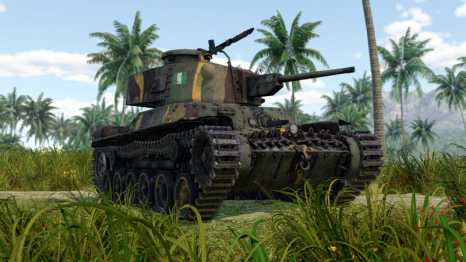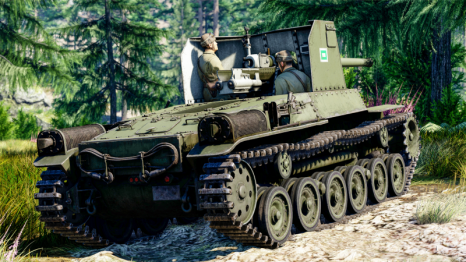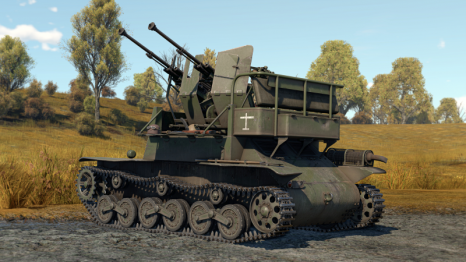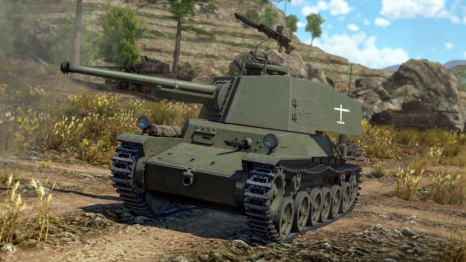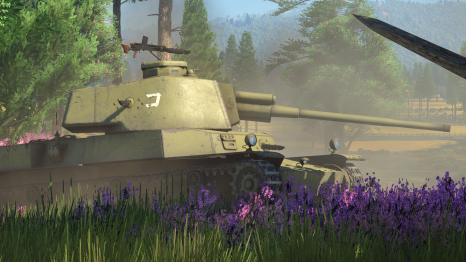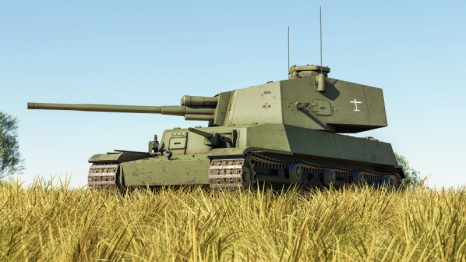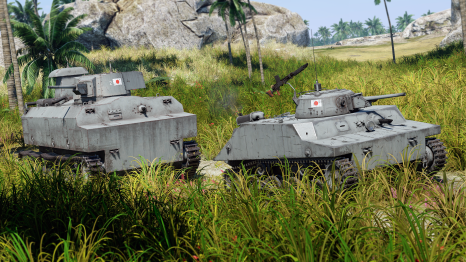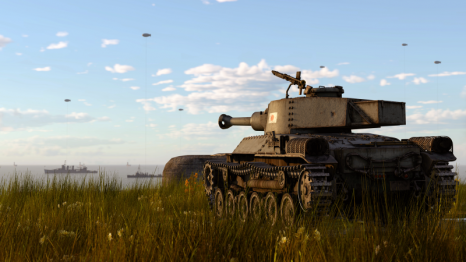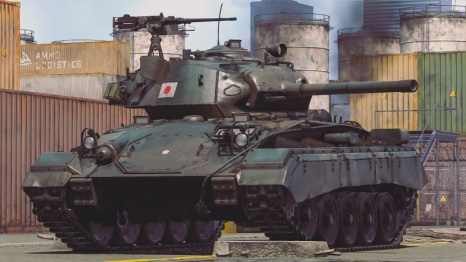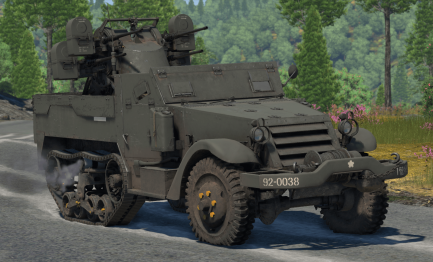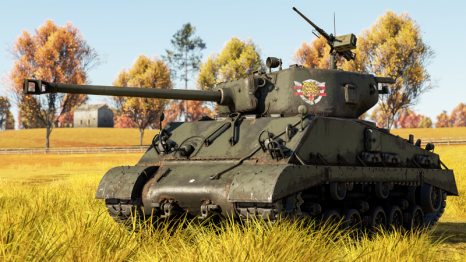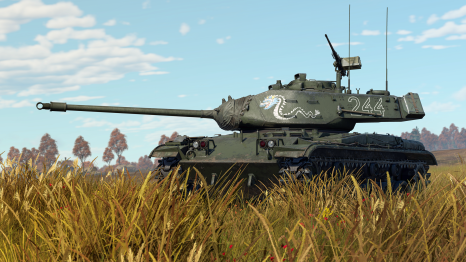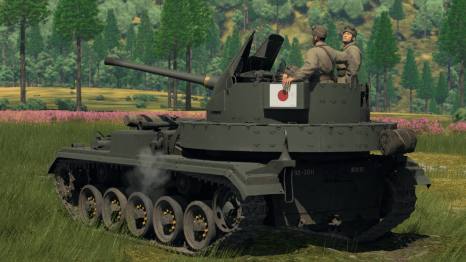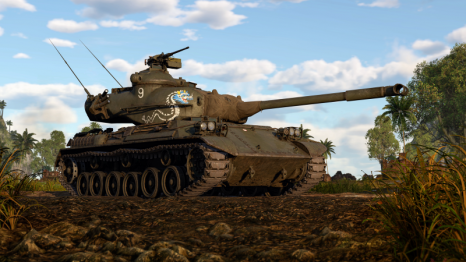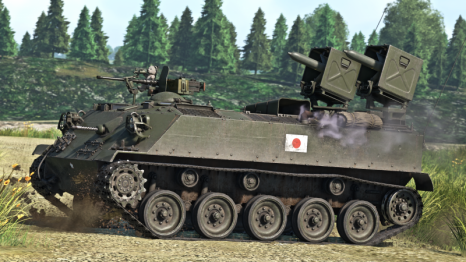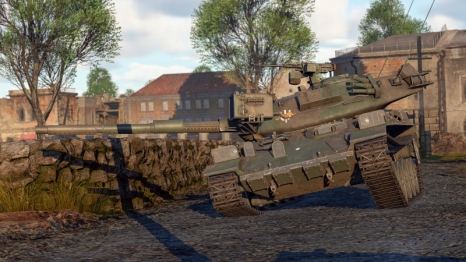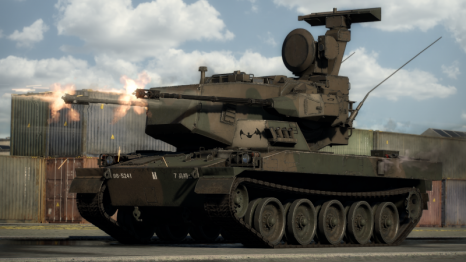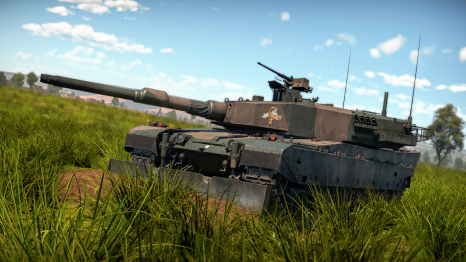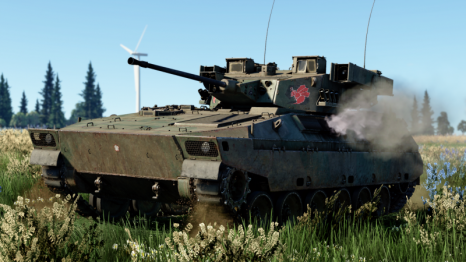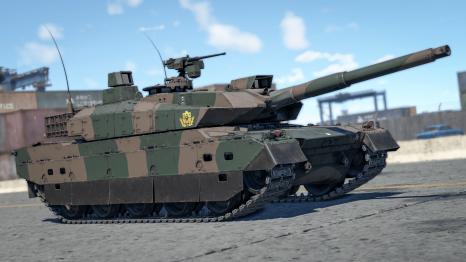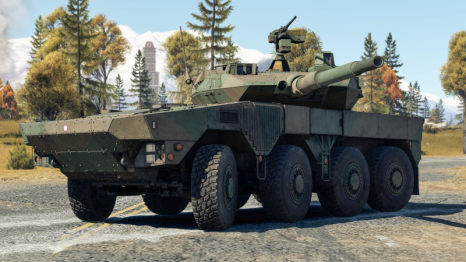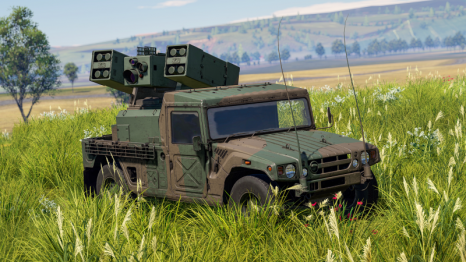Difference between revisions of "Japanese Ground Vehicle History"
| Line 98: | Line 98: | ||
The increased budget of the war also meant the possibility of upgrading the main force of the Japanese tank's army, with plenty of upgrades taken into development, welding the armour together instead of rivets, increasing its armour thickness and taking a more rounded armour to increase the bouncing of shells and the lower profile also meant more weight saved while still increasing speed. The main turret which was also rounded out, was increased to 2 manned as well after eliminating the hull mounted machine gun and instead mounting it to the side of the main gun. While the Ke-Ni was superior over the Ha-Go in every regard, the Japanese Army still prioritized the manufactory of the Ha-Go as it proved itself on the battlefield, sufficient reliability and the differences in performance weren't decisive enough. | The increased budget of the war also meant the possibility of upgrading the main force of the Japanese tank's army, with plenty of upgrades taken into development, welding the armour together instead of rivets, increasing its armour thickness and taking a more rounded armour to increase the bouncing of shells and the lower profile also meant more weight saved while still increasing speed. The main turret which was also rounded out, was increased to 2 manned as well after eliminating the hull mounted machine gun and instead mounting it to the side of the main gun. While the Ke-Ni was superior over the Ha-Go in every regard, the Japanese Army still prioritized the manufactory of the Ha-Go as it proved itself on the battlefield, sufficient reliability and the differences in performance weren't decisive enough. | ||
{{Break}} | {{Break}} | ||
| + | |||
| + | ====Battles of Khalkhin Gol==== | ||
| + | {{Notice|Japanese Political War Doctrines: | ||
| + | Japan's path to war was marked by intense interservice rivalry and doctrinal clashes. The main doctrines, Northern and Southern Expansion, respectively focused on expanding into Northern Asia against Russia/USSR (Army-supported) and into Southeast Asia and the Pacific (Navy-supported). For the Southern expansion, Army factions favored counterclockwise expansion (Island hopping), while Navy factions supported clockwise expansion (Claiming naval dominance).}} | ||
| + | |||
| + | The last pivotal point in Japanese war policy occurred after the battles of Khalkhin Gol, stemming from border disputes with Soviet-Mongolia. These skirmishes escalated into a larger conflict, pitting Japanese units against Soviet troops. The Soviet Union's effective use of tanks, notably the BT series, underscored the significance of armored warfare. Meanwhile, Japan, relying on infantry support tanks like the Ha-Go and Chi-Ha, lacked adequate anti-tank capabilities, proving detrimental in countering Soviet armored assaults. These battles resulted in a significant defeat for Japan and a victory for the Soviet Union, leading to the signing of a ceasefire agreement and solidifying Soviet influence in the region. This prompted Japan to reevaluate its military standing. | ||
| + | |||
| + | The escalation of conflict at Khalkhin Gol occurred primarily due to actions by the Kwantung Army, without governmental authorization. Following the defeat, the signing of the Neutrality Pact, and the replacement and eventual purge of the largest supporters of the doctrine (Kōdōha faction), further attempts at the Northern Expansion Doctrine were disfavored. Priority and funds shifted to the Navy, and reforms within the Japanese army led to an increase in tank production from 500 to 1,200 annually. Additionally, a mechanized headquarters was established, returning Japanese tanks to a combined arms-focused development. This included the introduction of the [[Type 1 (47 mm)]] tank gun in response to the Soviet [[20-K (45 mm)]]. | ||
| + | |||
=== World War II === | === World War II === | ||
;Japanese Offensive | ;Japanese Offensive | ||
Revision as of 15:00, 17 April 2024
| Writing in process... This article is being edited by the member Shimakaze (talk) 01:22, 15 April 2024 (UTC) (start date). Other participants are requested to not make any changes while this warning is here. |
- General proofreading, editing and information additions are fine by me, removal is discouraged. --Shimakaze (talk)
Contents
Historic Overview
Interwar
Type 89 I-Go (Late), 1929
Type 95 Ro-Go, 1935
Type 95 Ha-Go, 1935
After World War 1 ended, Japan followed suit to the new development of tanks after their own attempts at mechanizing their cavalry with armoured car experiments, which didn't suit the poor roads and extreme winter conditions in Manchuria. The Japanese Army therefore bought the following vehicles from their then Allied nations to kickstart Japanese tank development; one British Heavy Mk. IV (Female), several Medium Mk. A "Whippet" and a dozen French Renault "FT"s
| Imported tanks (1917-1930) | |||||
|---|---|---|---|---|---|
| Origin | Vehicle | Amount | Year Developed |
Japanese Introduction | |
| |
Mark IV Heavy Tank | 1 | 1917 | 1918 | |
| |
Mark A Medium Tank, Whippet | 3-6* | 1917 | 1919 | |
| |
Renault "FT" Light Tank | 20* | 1917 | 1919 | |
| |
Saint-Chamond mod. 1921 | 1 | 1921 | 1924 | |
| |
Mark C Medium Tank, Vickers Mk III | 1 | 1921 | 1927 | |
| |
Fiat 3000 | 2 | 1921 | 1928 | |
| |
Renault "NC" Light Tank | 23 | 1927 | 1930 | |
| |
Mark E Light Tank, Vickers 6 ton | 1 | 1928 | 1930 | |
| |
Mark VIb Tankette, Carden Loyd Tankette | 2+6 | 1927 | 1930 | |
| Editorial Note About "Chi-I" (Prototype No.1) and "Chi-Ro" (I-Go):
While internally these vehicles were retroactively counted into the Japanese IRoHa tank naming (chi-I, chi-RO, chi-HA, ...) these never were actually referred to as Chi-I and Chi-Ro. Prototype No.1 & No.2 (Type 91 Heavy) were never adopted for service, and never got a "proper name / designation", the I-Go was the first adopted tank and was named under the short lived "X-Go" naming, also going of the IRoHa, with the scheme simply translating to "Xth - Tank": I-go = 1st Tank, RO-go = 2nd Tank, HA-go = 3rd Tank Some sources even suggest that the "I-Go Ko" & "I-Go Otsu" were internalized as "Chi-I" and "Chi-Ro" respectively, others mention I-Go and Ro-Go as "Chi-I" and "Chi-Ro" as these were the first 2 adopted tanks of the heavy/medium category. |
The Army Technology Headquarters approved the development of a domestic tank, spearheaded by Tomio Hara, a young Japanese officer who after plenty of tank studies and advocation for Japanese tank development would become the father of many Japanese tank designs and principals. His and domestically first Japanese tank eventually resulted into, simply known as, the 試製一号戦車 (Prototype Tank No.1) which was developed under a tight deadline. With most of the struggles not coming from designing the tank itself, the Japanese industry simply didn't have the tools or manufacturing set-up for tank development, with the Army opting to utilize the Osaka Arsenal (State Weapons Factory) instead of the then new and fragile Automotive industry which meant all parts had to be precisely crafted with 10,000s of blueprints drawn up for everything together. With the prototype finished by February, 1927, just a month short of its 22 month deadline to March, the tank was tested at famous Fuji training range by June 21. After civilians and military personnel alike watched the First Japanese tank in motion, tests concluded that it was far superior over its Western imports in both handling, firepower and easy operation and established a confidence in domestic tank design.
While the first Japanese tank reinforced the development and research into domestic tanks, the prototype was far too heavy at 18 tonnes at a requested of 12 tonnes, and prompted Tomio back to the drawing board for a lighter main tank at around 10 tonnes, with development inspired by the 1927 British imported Vickers Medium Mk.C (Export Vicker Medium Mk.III, not to be confused with the Medium Mk.C "Hornet"). By 1929 the new I-Go was ready and its first prototype rolled out of Osaka Arsenal, and further mass production was assigned to Mitsubishi Aircraft, which would continue to mass-produce most of the Japanese tanks afterwards to this day. By the time of adoption, it would be known as the Type 89 "I-Go" Light Tank, as its prototype only weighed at around 9 ton, and production weighed in at 11.8 ton, this would only change to become the Type 89 "I-Go" Medium Tank after Headquarters reviewed its tank doctrine, added the new role of medium tank instead of just light and heavy, and replaced its light tank role to the Type 95 "Ha-Go" Light Tank.
While production of Japan's new main-line tank just started, the Army still decided to buy more Western tanks to bolster and replace older models while also learning out of the newest advances their Western counterparts were making in 1930, Buying multiple Renault "NC"s from France, and several British Carden Loyd tankettes and Vickers 6-Ton tanks. The tankette was, like multi turreted designs, a venture the Japanese felt was a required branch of tank that had to be developed and researched, with multiple attempts at building tankettes ranging from the earliest Type 92 cavalry tank (and its amphibious prototypes) and Type 94 tankette, finding mobility a nice feature in-combat and scouting but lacking any serious use case due to the limited firepower and limited upgrade possibility of a MG armed tank. The latter Type 94 tankette also featured and introduced Tomio Hara's bell crank scissors suspension which would be the de facto suspension of all following Japanese tanks as it proved very successful for off-road operations and reducing overall maintenance cost.
With the early-mid 1930s rolling by, Japan uses its newly established tank forces in Manchuria and Chinese border skirmish battles, proving the values of Japanese tanks. Though the advancements in the automotive industry increased the mobility of mechanized infantry units, averaging 40 km/h divisional speed, kept the heavier and slow I-Go behind which maxed out at 25 km/h, and that staggered down to 12 - 8 km/h off-road, which for frontline movement under infantry marches was good enough. With the Japanese focus on light tanks as a main force and an increasing max speed for mobility, the 1928 I-Go design started falling behind for the mid 30s and a replacement was in-order. With the previous imported British tanks and tankettes and Japanese attempts at making tankettes, resulted into the new main tank of the Japanese Army, the Type 95 "Ha-Go" Light Tank. Development of the Ha-Go started even before the replacement of the I-Go was requested, with the original request coming from the Kwantung Army to devise an experimental mechanized unit (would become "1st Mixed Brigade") to the then Mitsubishi Aircraft, making this the first tank based on a prototype of a private company.
| Japanese Machine Gun Doctrine:
While it may seem odd why Japanese tank machine guns are standard infantry magazine fed, this was a deliberate choice taking into account the Japanese doctrine around automatic machine guns, preferring a more accurate and long range engagement on the machine gun, it was heavily implied that every shot counted and that it wasn't simply for suppressing enemy targets as every bullet was meant to hit. This would in theory save cost and bullets, and the additional benefit of reducing logistical strains by taking standard infantry ready munitions. |
Second Sino-Japanese War
Type 97 Chi-Ha, 1937
Type 98 Ke-Ni, 1938
Type 94 (20 mm Type 98), 1938
With Japanese tank development continuing and tank reports coming back from frontline border skirmishes, by 1936 a new infantry support tank was requested as the I-Go, while modestly successful at the front, was too slow for Japanese liking. The new tank program was to suit the role of medium tank, supporting infantry and the main force of Ha-Gos, improvements were requested towards armour, taking in account body construction and penetration defense (i.e. angled armour) and primarily increasing the speed so it keeps up with both infantry and light tanks. The diesel engine the Japanese put in their previous tanks since the I-Go Otsu model, has proved as a necessity as the fuel used was easier to obtain than gasoline, less volatile and flammable, alternative ways to procure diesel out of oil shale and even Soybeans and the Manchurian battlefield conditions that were taken into account in extreme colds were more ideal air-cooled diesel to prevent the need of restocking or freezing coolant which only downsided in requiring a larger air-cooled diesel engine to obtain the same output as a gasoline engine. So the biggest concern was an increase in weight while keeping the diesel engine, resulting in an increase in material cost, with mixed opinions on investing more cost for more performance or saving weight and cost at the cost of survivability and speed, which resulted into two branching prototypes based on both concepts. The Army Technical Headquarters devised both concepts under Plan A (甲 , Kō) and B (乙 , Otsu) resulting as planned with:
Plan A - More Expensive: 13.5 tons 2 manned turret 2 machine guns (1 hull, 1 rear-side turret) Roughly same crew compartment size as the I-Go Plan B - Cheap Alternative: 10 tons 1 manned turret 1 machine gun (1 hull, removed out of the turret)
The Imperial Japanese Army General Staff Office requested Plan A to be reduced to 12 tons, which the Technical Headquarters couldn't comply with as the prototype hit 15 tons, resulting in the idea to mass deploy Plan B to make up for the performance difference by using the "saved" cost. Though out of the Tank school's opinion the 2 manned turret is an absolute and essential advantage over a 1 manned turret even if the alternative vehicle has acceptable speed and armour. With neither concepts being able to find a compromise, this possibly resulted in a third prototype development (unrelated to the initial order), which was later known as the "Type 98 Chi-Ho medium tank".
| Japanese Tank Doctrine into the 30s:
With all nations during the interwar conflicting over an infantry based tank force or independent tank unit for a combined arms doctrine, the Japanese had effectively used combined arms tactics in 1933 during the battle of Rehe, which saw the use of mechanized infantry with Type 89s "I-Go" overtake the retreating Chinese troops to the capital of Rehe, Chengde. Other instances of combined arms tactics also occurred but were ignored by Hideki Tojo who favoured an infantry centered attack with spread out armour support. This change in tactic favoured very poorly at Chinese defenses with proper anti-tank defenses against thinly spread tanks and reduced the importance of Japanese tank funding. |
With the Second Sino-Japanese war kicking into a full-blown war, Military funding increased drastically which tipped the balance of favour for Plan A, being now put in service as the Type 97 "Chi-Ha" Medium Tank, resulting in the Plan B "Chi-Ni" to be left behind with its singular prototype built. The Chi-Ha was also the first Japanese tank to be default equipped with radio equipment, which the previous I-Go and Ha-Go only started experimenting with around 1937 as radio equipment got smaller, relying on signal flags before that and specialized command variants of tanks being the sole vehicles with radios equipped.
The start of the war also showcased the developments of the sky in ground combat, deeming machine guns as insufficient as anti-air defense against constantly increasing air speed and defense and the response time of towed anti-air in convoys was too slow, so the quickest response for defending moving units in movement was equipping the standard Japanese truck with the gun it was towing, which became the standard Japanese self propelled anti-air for the remainder of the war. Development of self-propelled anti-air didn't stop here however and moved first towards half-tracks before being developed onto full tracked tanks. With initial prototypes developing off the Type 97 Te-Ke light tank into the experimental Ki-To self propelled anti-air, developing further on the following Type 98 Ke-Ni light tank towards the experimental Ta-Se and So-Ki.
The increased budget of the war also meant the possibility of upgrading the main force of the Japanese tank's army, with plenty of upgrades taken into development, welding the armour together instead of rivets, increasing its armour thickness and taking a more rounded armour to increase the bouncing of shells and the lower profile also meant more weight saved while still increasing speed. The main turret which was also rounded out, was increased to 2 manned as well after eliminating the hull mounted machine gun and instead mounting it to the side of the main gun. While the Ke-Ni was superior over the Ha-Go in every regard, the Japanese Army still prioritized the manufactory of the Ha-Go as it proved itself on the battlefield, sufficient reliability and the differences in performance weren't decisive enough.
Battles of Khalkhin Gol
| Japanese Political War Doctrines:
Japan's path to war was marked by intense interservice rivalry and doctrinal clashes. The main doctrines, Northern and Southern Expansion, respectively focused on expanding into Northern Asia against Russia/USSR (Army-supported) and into Southeast Asia and the Pacific (Navy-supported). For the Southern expansion, Army factions favored counterclockwise expansion (Island hopping), while Navy factions supported clockwise expansion (Claiming naval dominance). |
The last pivotal point in Japanese war policy occurred after the battles of Khalkhin Gol, stemming from border disputes with Soviet-Mongolia. These skirmishes escalated into a larger conflict, pitting Japanese units against Soviet troops. The Soviet Union's effective use of tanks, notably the BT series, underscored the significance of armored warfare. Meanwhile, Japan, relying on infantry support tanks like the Ha-Go and Chi-Ha, lacked adequate anti-tank capabilities, proving detrimental in countering Soviet armored assaults. These battles resulted in a significant defeat for Japan and a victory for the Soviet Union, leading to the signing of a ceasefire agreement and solidifying Soviet influence in the region. This prompted Japan to reevaluate its military standing.
The escalation of conflict at Khalkhin Gol occurred primarily due to actions by the Kwantung Army, without governmental authorization. Following the defeat, the signing of the Neutrality Pact, and the replacement and eventual purge of the largest supporters of the doctrine (Kōdōha faction), further attempts at the Northern Expansion Doctrine were disfavored. Priority and funds shifted to the Navy, and reforms within the Japanese army led to an increase in tank production from 500 to 1,200 annually. Additionally, a mechanized headquarters was established, returning Japanese tanks to a combined arms-focused development. This included the introduction of the Type 1 (47 mm) tank gun in response to the Soviet 20-K (45 mm).
World War II
- Japanese Offensive
Type 97 Chi-Ha Kai, 1942
Type 1 Ho-Ni I, 1941
Experimental So-Ki, 1942
- Japanese Defensive
Type 3 Chi-Nu, 1943
Type 4 Chi-To, 1944
Type 5 Chi-Ri, 1945
Type 1 Ka-Mi and Type 3 Ka-Chi, 1941 - 1943
Chi-Ha Short Gun, 1945
Chi-Ha LG, 1945
Cold War
NPR / NSF
M24 Light Tank, 1952
M16 MGMC, 1952
JSDF
M4A3(76) Medium Tank, 1954
M41 Light Tank, 1961
M19 MGMC, 1954
Type 61 Medium Tank, 1961
Type 60 SPRG, 1960
Type 60 ATM, 1964
Type 74 MBT, 1974
Type 87 RCV, 1987
Type 87 SPAA, 1987
Type 90 MBT, 1990
Type 89 IFV, 1989
Modern Day
Type 10 MBT, 2010
Type 16 MCV, 2016
Type 93 SAM, 1993


